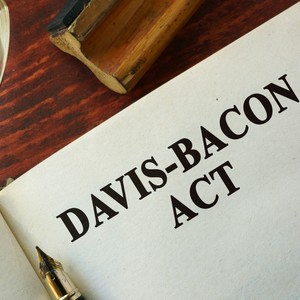Posted on Jul 9, 2018
The Davis-Bacon Act is a federal prevailing wage law governed by the Department of Labor that applies to contractors and subcontractors who perform work on government projects in excess of $2,000 for construction, repair, or alteration. Laborers and mechanics employed on the project job site must be paid the prevailing wage rate, including fringe benefits. The prevailing wage rate is based on wages and fringe benefits paid to laborers and mechanics employed in similar projects in the area. [1] The Davis-Bacon and Related Acts (DBRA) are intended to level the playing field between bids submitted by open shops and union shops.
Other requirements for contractors (and subcontractors) include paying covered workers on a weekly basis, submitting weekly certified payroll records to the contracting agency, posting a Davis-Bacon poster that is easily accessible to workers on the job site, and maintaining accurate records during the course of the work and for a period of three years after the project has ended.
The employer has flexibility in how to satisfy the Davis-Bacon requirement. With respect to the prevailing wage and fringe benefits listed in a Davis-Bacon wage determination:
- Covered employees can be paid both wage and fringe portions in cash;
- The employer can pay the wage portion in cash and the fringe portion through a contribution to a benefit plan;
- A combination of cash wages paid and bona fide fringe benefits may be used together to meet the total required prevailing wage. Fringe benefits include retirement plans, life insurance, health insurance, supplemental unemployment benefits, and vacation, holiday and sick leave.
Paying covered employees in cash for both the wage and fringe portions is the most expensive option for employers because of payroll taxes and other compensation-related costs. However, if the employer offers a prevailing wage plan in which fringe contributions are made to a benefit plan, such as a qualified retirement plan in which the employee is fully vested, the payment is not subject to FICA and other payroll taxes. The employer can also opt to use prevailing wage contributions to offset a company-required profit-sharing or matching contribution.
Other advantages may include lowered general liability premiums and decreased workers’ compensation premiums since fringe benefits are not considered part of payroll. Employees also save when benefits are purchased on a pre-tax basis. For example, if the employer combines the prevailing wage plan with a 401(k) plan, employees can reduce their personal income tax liability through their contribution on a pre-tax basis to a retirement plan that has tax-deferred earnings. In addition, employers with a Safe Harbor 401(k) plan may opt to utilize the prevailing wage fringe to offset the required Safe Harbor contribution.
Prevailing wage contributions to a qualified benefit plan offers significant advantages to both the employer and the employee. However, a TPA familiar with Davis-Bacon requirements and ERISA is essential for these plans to be in compliance and properly maintained. Plan design including eligibility requirements, vesting, timing of contributions, service crediting method, treatment of forfeitures, and other features must be carefully considered.
Have questions about setting up a prevailing wage plan? The TPS Group can help. Call us at 1-855-828-2229.
This material is provided for informational purposes only, and is not intended as authoritative guidance, legal advice, or assurance of compliance with state and federal regulations.
[1] https://webapps.dol.gov/elaws/elg/dbra.htm

